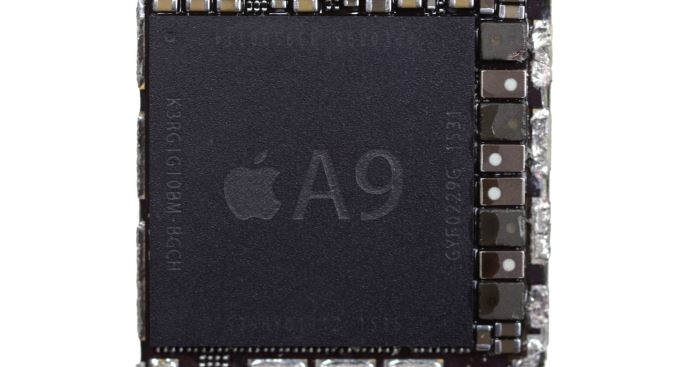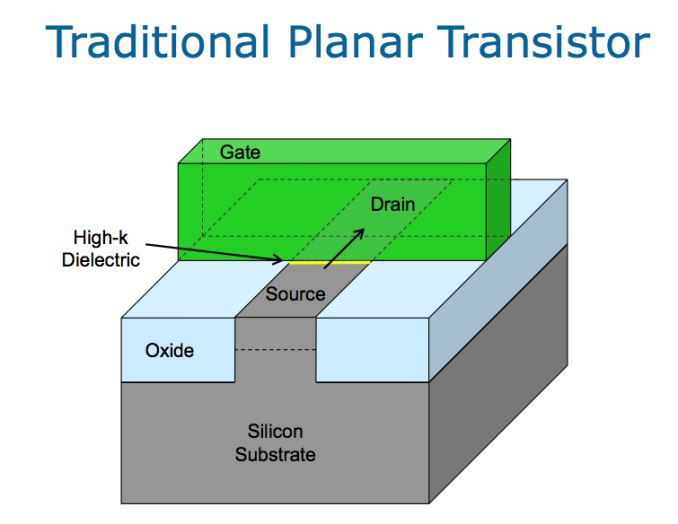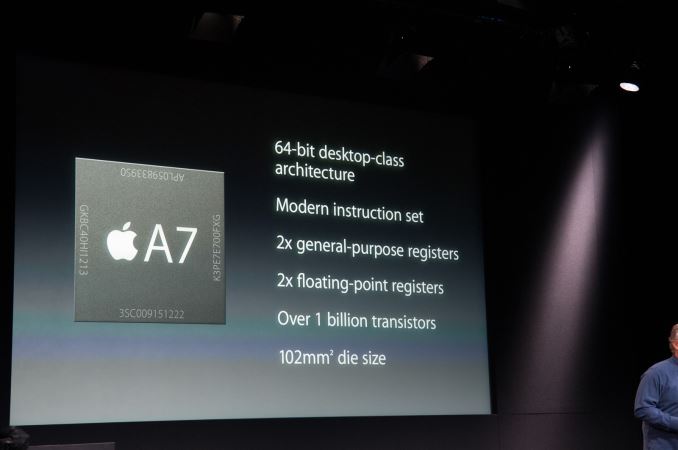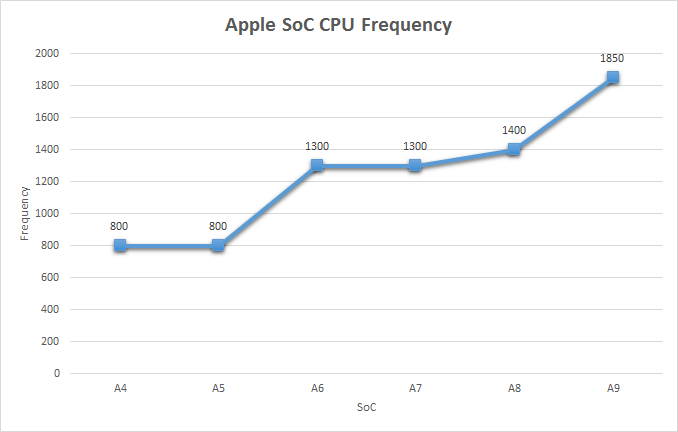The Apple iPhone 6s and iPhone 6s Plus Review
by Ryan Smith & Joshua Ho on November 2, 2015 8:00 AM EST- Posted in
- Smartphones
- Apple
- Mobile
- SoCs
- iPhone 6s
- iPhone 6s Plus
Analyzing Apple A9’s SoC
For Apple’s engineering teams, I’m still undecided whether Apple’s tick-tock style of SoC development is a curse or a blessing. That Apple more strongly invests in SoC development for the iPhone-S processors is a blessing, as it gives the engineering teams a bit of time to breathe and to plan out major architecture shifts over two years. On the other hand even for non-S iPhones the engineering teams still need to deliver an amazing product – iPhone 5 and iPhone 6 were no slouches – so I’m not sure how much of a breather the engineering teams actually get. They may have two years to space some of their transitions, but they must continue to deliver a top-tier SoC every year.
When Apple released the A7 SoC alongside the iPhone 5s in 2013, they pulled off something that rocked the SoC industry. The Cyclone CPU core all but came out of nowhere, beating previous estimates for the first ARMv8 64-bit phone SoCs (by any vendor) by roughly a year. As a result the 64-bit transition became a lot more important a lot sooner than anyone was expecting, and to this date some of Apple’s SoC competitors are still trying to recover from the shock of having to scramble to go 64-bit sooner than they planned.
As for Apple’s engineering teams, that we’re on another iPhone-S year means that there’s quite a bit of pressure to pull off a repeat performance, and I suspect that pressure is internal as much as it is external. A7 brought with it Cyclone, a CPU that was not only 64-bit, but thanks to its exceptional (for a mobile CPU) issue width of 6 micro-ops, brought with it a huge jump in single-threaded performance. At the same time A7 also saw Apple transition to PowerVR’s Rogue architecture GPUs (PowerVR G6xxx), which was a similar jump in GPU capabilities and performance, along with setting the stage for Apple’s proprietary, low-level Metal graphics API. A7 was everything Apple needed and more, cementing Apple’s place as a top-tier SoC designer and laying the groundwork for the performance advantage Apple has enjoyed over the past two years.

Apple's A9 SoC (Image Courtesy iFixit)
For 2015 then and for their latest iPhone-S, Apple has once again turned out a new SoC. This brings us to the A9, and in a year with an iPhone-S and almost no external design changes to speak of, all eyes are on what Apple has devised to go inside their phones.
| Apple A9 vs A8 SoCs | ||||
| Apple A9 (2015) | Apple A8 (2014) | |||
| Manufacturing Process | TSMC 16nm FinFET / Samsung 14nm FinFET |
TSMC 20nm HKMG | ||
| Die Size | 104.5mm2/96mm2 | 89mm2 | ||
| CPU | 2 x Apple Twister ARMv8 64-bit cores |
2 x Apple Typhoon ARMv8 64-bit cores |
||
| GPU | IMG PowerVR GT7600 | IMG PowerVR GX6450 | ||
Finally Fabbed with FinFETs
When the iPhone 6 launched I spent some time talking about how for the A8 SoC, Apple finally reached the point where they were building SoCs on a leading edge manufacturing process. That process at the time being TSMC’s 20nm planar process. The fact that Apple was building on a leading edge process was important for two reasons: 1) It was a strong indicator of how serious they were about SoC production and how much they were willing to spend in order to achieve the best possible performance, and 2) it meant that Apple had finally completely climbed the ladder (so to speak) and wouldn’t be able to “exceed the curve” just by catching up on manufacturing technology. Post-A8, Apple can only improve their performance by improving their architecture, building bigger chips, and finally, jumping to newer manufacturing processes as they become available.
What wasn’t said at the time – due to the fact that no one outside the fabs was quite sure – was where Apple would go in 2015. Had you asked me in 2014 what I would expect the A9 to be fabbed on, I would have suggested another round on TSMC’s 20nm process now that Apple had caught up to the leading edge. However much to my surprise (and to a steak dinner I lost a bet on) Samsung was able to get their 14nm FinFET process yielding well enough to supply Exynos 7420 in bulk for the Galaxy S6 launch nearly 6 months ago.
The fact that one of the contract fabs was able to get a FinFET process up and yielding well enough for volume production before the very end of 2015 has definitely changed the picture for what Apple can do. Once again they get to jump to a new manufacturing process for their next SoC, though this time by staying on the leading edge.


Planar vs. FinFET (3D) Transistors (via Intel)
While I’m not going to go into the physics of FinFET in depth here – we have some great articles on that already – I do want to quickly touch upon why this is so important. 14nm (and 16nm) FinFET isn’t just a new manufacturing node, but it’s part of a broader change in how transistors are manufactured. Simply put, FinFET (aka 3D transistors) are a long in development technology meant to help transistors scale to increasingly small scales, on the order of dozens of atoms or less.
FinFET transistors are necessary because as transistors get smaller their leakage (wasted power) goes up, and without FinFETs leakage would spiral out of control. In fact that’s exactly what happened on the 20nm nodes from Samsung and TSMC; both companies thought the leakage of planar transistors could be adequately controlled at 20nm, only for leakage to be a bigger problem than they expected. Due in large part to this reason, the 20nm SoCs released over the last 18 months have more often than not struggled with power consumption and heat, especially at higher clockspeeds. Apple is something of the exception here, with the 20nm A8 proving to be a solid SoC, thanks in part to their wide CPU design allowing them to achieve good performance without using high clockspeeds that would exacerbate the problem.
That said, while Apple managed to handle 20nm well enough, they were still ultimately at the mercy of a subpar process. The 14nm/16nm FinFET processes are what 20nm should have been all along, with the use of FinFETs drastically cutting down on leakage and reducing operating voltages – and now that FinFETs are here Apple no longer has to be as conservative as they were with A8. What that gives Apple then is a chance to push the envelope much harder on clockspeeds, taking their already wide CPU designs and turning up the clockspeeds as well.












531 Comments
View All Comments
TitaniK - Friday, November 13, 2015 - link
I used to be so pro android and have tried all main phones on the market; Samsung 3&4, note3,4, htc one m7, nexus 4. I need my phone constantly mainly for business as well as pleasure and at the end, i surrendered to Apple product; so reliable, fast and just clean. It's just a well tuned machine. I compare it this way; android is the NASCAR of mobile devices where Apple is Formula 1. Cars go very fast in both organizations but the Formula 1 machines are simply finer tuned and polished machines.10basetom - Sunday, November 8, 2015 - link
Even though my last two phones have been Androids, I would have to agree with the reviewer's assessment that Android phones have been, more or less, a zero sum game. You can call me jaded, but there's not a single Android phone in the past year that has gotten me truly excited, maybe with the exception of potentially cheaper (relative to YotaPhone 2) dual screen phones coming out of China that would change how you use a phone on a daily basis. PDAF, laser autofocus, and RAW support are nice specs to have for a limited group of photography aficionados, but I don't consider them real innovation in the overall user experience department. Most consumers (i.e., non-geeks) who use phones to take everyday photos will not notice -- or even care -- whether their phone has PDAF or not; and for people who want to take frameable photos, they would probably do so with a tripod and DLSR rather than a mobile phone. Besides, the cameras in the iPhone 6s' are nothing to laugh at.When I think of progress in mobile OS usability, it would have to be something that gives the end user more pleasure in using it, or increase their productivity in a measurable way (e.g., less time in doing something, fewer taps). Maybe I've just been using Android for too long, but there is nothing in Lollipop or what I've seen of Marshmallow that makes me stop and silently shout "damn, that is impressive!". Sure, the interface is a little more streamlined with enhanced jazzy animations (that I turn off anyway to improve performance), and some new iterative features sprinkled here and there, but nothing revolutionary. It's unfortunate that most Android phone manufacturers build a custom skin on top that more often than not makes the phone less usable and more buggy, and also more confusing when you move from one Android phone to the next.
The WinCE-based Neno OS that introduced a 100% swipable interface and weaned people off the stylus two years before the original iPhone -- that's way into revolutionary territory. The pulley menu system in Sailfish OS -- now that's something refreshing. It may not be everybody's cup of tea, but at least they are trying something different, and when you do get used to it, it really does improve one-handed usability. The 3D Touch interface in the new iPhones? Now that's bordering on revolutionary. Again, it may not seem apparent when you first use it, but after living with it for an extended period of time until it becomes habit, you would be hard-pressed to go back to a mobile phone without a pressure-sensitive touch layer. The exciting thing is that we are just scratching the surface of what 3D Touch can bring; and the module could be made thinner and lighter so that future iPhones won't get such a large weight bump.
Other than the superior A9 SoC which has already been widely discussed, the other big thing for me that Android phones have been dropping the ball on is storage architecture. Whereas most Android phones are still advertising eMMC 5.0 storage solutions, the iPhone 6s' have moved way beyond that. Samsung's move to UFS 2.0 is a step in the right direction, and I hope all other Android phone manufacturers will follow suit soon.
dusszz - Monday, November 30, 2015 - link
I've been a long time android user seriously thinking of switching to iphone. Android OS in general is not meant for high end devices because prior to nexus 6p, android is designed for nexus phone which is not a high end devices. The high end iteration of android as in galaxy s6/note 5 with skins feel fragmented and does not really in line with what google intended (material design). Sure they add features with that but it felt like they (high end oem) trying too hard to compete. I always feel the best android devices must come from nexus line but then it does not quite there at least just yet. Every innovation in android OS always feel like it is in beta because the implementation more for marketing rather than useful. For example, nexus 5 has OIS since 2013 but does not feel it has advantage over other phone that has EIS. Furthermore, decision google made to ditch OIS (nexus 6p/5x) further clarify it. I personally never have android phone for more than a year without feeling outdated in term of hardware. So if you think you buy $500 android phone thinking it can compete with iphone, its going to be disappointing. Android is at its best being a midranger.hans_ober - Monday, November 2, 2015 - link
at last!vFunct - Monday, November 2, 2015 - link
I wish he took proper photo tests.Tip: when testing cameras, do make sure to take photos of people. Don't take photos of brick walls.
You're going to find that most people take photos of people with their phones - at parties, selfies, etc..
A good camera test always includes people shots.
vFunct - Monday, November 2, 2015 - link
Basically you're looking for skin-tone reproduction quality.Klug4Pres - Monday, November 2, 2015 - link
I wonder if next year the Home button will disappear, which would help a lot with the bezeltastic design.zeeBomb - Monday, November 2, 2015 - link
That username...lol.I dunno man, the home button is the staple of iPhone Design since the very original. Might be pretty controversial if you'd ask me.
KoolAidMan1 - Tuesday, November 3, 2015 - link
The fingerprint reader is another big reason. If they can get it to be as fast and accurate as it is right now while reducing home button size then I can see them reducing the bottom bezel.Otherwise you're looking at making their fingerprint reader as flaky and undependable as Samsung or everyone else's
Tetracycloide - Tuesday, November 3, 2015 - link
The nexus 5x has been super solid.